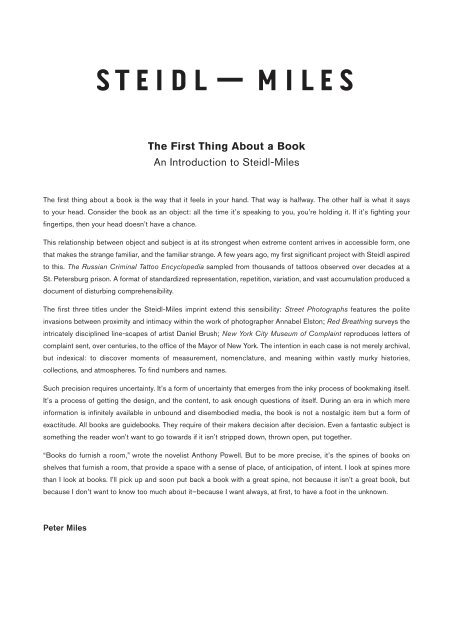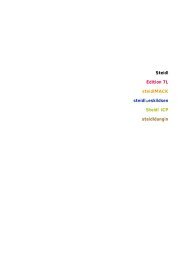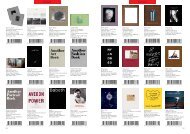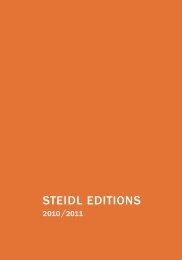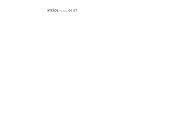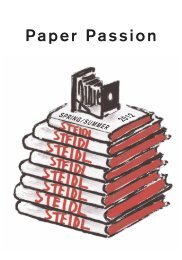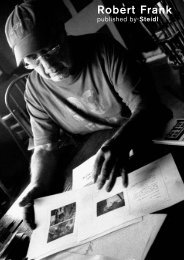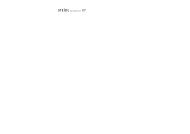The Lewis Baltz Library - Steidl
The Lewis Baltz Library - Steidl
The Lewis Baltz Library - Steidl
Create successful ePaper yourself
Turn your PDF publications into a flip-book with our unique Google optimized e-Paper software.
<strong>The</strong> First Thing About a Book<br />
An Introduction to <strong>Steidl</strong>-Miles<br />
<strong>The</strong> first thing about a book is the way that it feels in your hand. That way is halfway. <strong>The</strong> other half is what it says<br />
to your head. Consider the book as an object: all the time it’s speaking to you, you’re holding it. If it’s fighting your<br />
fingertips, then your head doesn’t have a chance.<br />
This relationship between object and subject is at its strongest when extreme content arrives in accessible form, one<br />
that makes the strange familiar, and the familiar strange. A few years ago, my first significant project with <strong>Steidl</strong> aspired<br />
to this. <strong>The</strong> Russian Criminal Tattoo Encyclopedia sampled from thousands of tattoos observed over decades at a<br />
St. Petersburg prison. A format of standardized representation, repetition, variation, and vast accumulation produced a<br />
document of disturbing comprehensibility.<br />
<strong>The</strong> first three titles under the <strong>Steidl</strong>-Miles imprint extend this sensibility: Street Photographs features the polite<br />
invasions between proximity and intimacy within the work of photographer Annabel Elston; Red Breathing surveys the<br />
intricately disciplined line-scapes of artist Daniel Brush; New York City Museum of Complaint reproduces letters of<br />
complaint sent, over centuries, to the office of the Mayor of New York. <strong>The</strong> intention in each case is not merely archival,<br />
but indexical: to discover moments of measurement, nomenclature, and meaning within vastly murky histories,<br />
collections, and atmospheres. To find numbers and names.<br />
Such precision requires uncertainty. It’s a form of uncertainty that emerges from the inky process of bookmaking itself.<br />
It’s a process of getting the design, and the content, to ask enough questions of itself. During an era in which mere<br />
information is infinitely available in unbound and disembodied media, the book is not a nostalgic item but a form of<br />
exactitude. All books are guidebooks. <strong>The</strong>y require of their makers decision after decision. Even a fantastic subject is<br />
something the reader won’t want to go towards if it isn’t stripped down, thrown open, put together.<br />
“Books do furnish a room,” wrote the novelist Anthony Powell. But to be more precise, it’s the spines of books on<br />
shelves that furnish a room, that provide a space with a sense of place, of anticipation, of intent. I look at spines more<br />
than I look at books. I’ll pick up and soon put back a book with a great spine, not because it isn’t a great book, but<br />
because I don’t want to know too much about it–because I want always, at first, to have a foot in the unknown.<br />
Peter Miles


